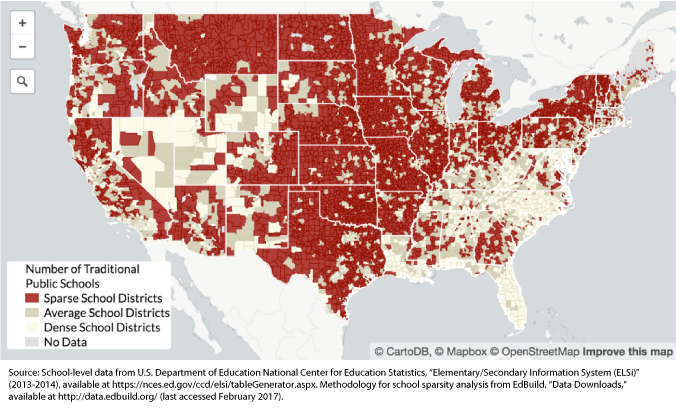Vouchers Are Not a Viable Solution for Vast Swaths of America
President Donald Trump offered one major K-12 education proposal during the presidential campaign: a $20 billion plan that would reprioritize existing federal education funds to provide vouchers for private-school choice. And with his selection of Betsy DeVos as secretary of education, who has been referred to as the “four-star general of the pro-voucher movement,” he signaled the seriousness with which he intends to pursue this idea as a solution to what Trump has called “failing government schools” and DeVos has called a “dead end” public education system.
Much has been written about the devastating impact such a proposal would have on local communities, since $20 billion would subsume most federal K-12 education spending. Currently, that spending is specifically targeted to low-income students, students with disabilities, English language learners, and other vulnerable children. But little has been written about the fact that the proposal misses the mark when it comes to the real challenges facing the vast majority of school districts across the country. The simple fact is that most rural and suburban areas are either sparsely populated or organized in small districts where there are not enough schools for vouchers to be a viable or effective policy solution. In these districts, vouchers would be not just ineffective, but they could also dramatically destabilize public school systems and communities.
Underscoring this point is the fact that Republican Sens. Lisa Murkowski (AK), Susan Collins (ME), and Mike Enzi (WY) all used their limited time for questions during DeVos’ confirmation hearing to speak about the special challenges facing rural and frontier schools in their states.
In order to examine the viability of vouchers throughout the nation, the Center for American Progress used data and visuals published by EdBuild, a national nonprofit focused on improving the way states fund public schools. The organization mapped data from the National Center for Education Statistics to visualize the density and diversity of America’s school districts. The goal was to get a handle on the number of schools in districts of varying size across the country and the locations of those districts. The interactive map allows users to see where districts are that fit into the following categories:
- Sparse districts: a unified school district with four or fewer schools, an elementary-school-only district with three or fewer schools, or a secondary-school-only district with two or fewer schools
- Average districts: a unified school district with five to eight schools, an elementary-school-only district with four to five schools, or a secondary-school-only district with three to five schools
- Dense districts: a unified school district with nine or more schools, an elementary-school-only district with six or more schools, or a secondary-school-only district with six or more schools

The findings underscore the severe limitations of President Trump and Secretary DeVos’ one-size-fits-all vision of nationalizing private-school vouchers. Public education in America is far from one-size-fits-all, and there is dramatic diversity within the more than 13,000 school districts across the nation—from the 1 million students in New York City’s more than 1,500 public schools, to the 60 students at the K-8 school on Beals Island, Maine, and its 100-student high school shared with the nearby town of Jonesport. Diversity can also be found among the 67 countywide districts in Florida educating more than 2.5 million students, the 545 districts in New Jersey educating nearly 1.3 million students, and the 413 districts educating fewer than 150,000 students in Montana.
When CAP staff members looked at the data, they found that there are:
- Nearly 9,000 sparse school districts that have four or fewer schools where voucher proposals are highly unlikely to work and could decimate the public system
- Another 2,200 average school districts that have five to eight schools where vouchers may not work and risk harming existing schools’ ability to serve millions of students
After excluding charter schools and regional agencies that are legally considered school Vouchers Are Not a Viable Solution for Vast Swaths of America – Center for American Progress:

